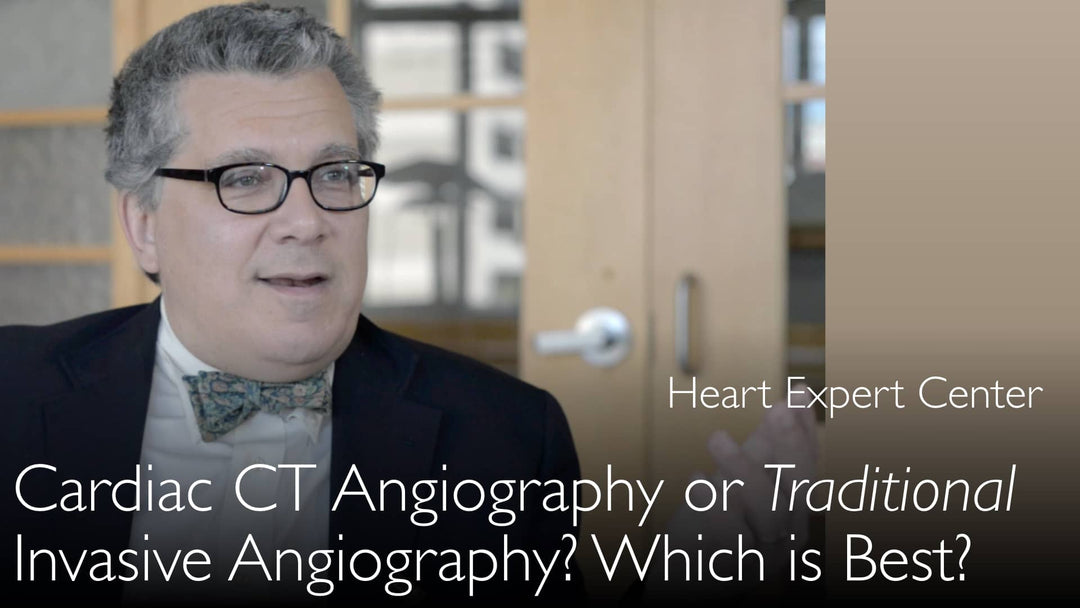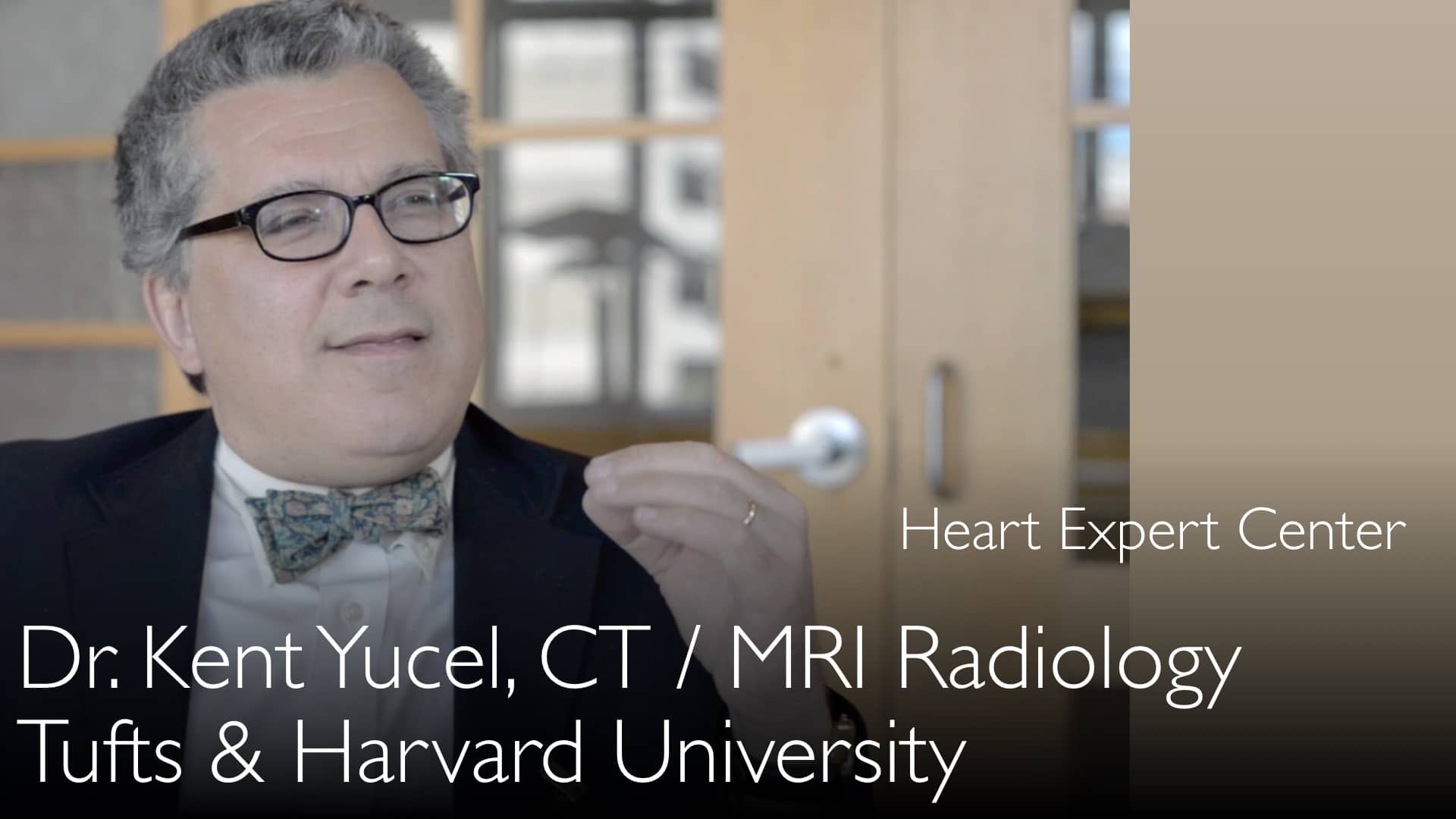CT血管造影とMRI血管造影の世界的権威であるKent Yucel医師(医学博士)が、CT冠動脈造影と侵襲的冠動脈造影の使い分けについて解説します。各検査法の明確な臨床的意義を詳述いたします。CT血管造影は、冠動脈疾患が疑われるものの確定診断に至っていない患者の評価において、優れた非侵襲的検査法です。高い陰性的中率を有し、有意な狭窄の存在を効果的に否定できます。これにより、不必要な侵襲的心臓カテーテル検査の多くを回避することが可能となります。技術の進歩に伴い、CT血管造影の被曝線量は大幅に減少し、現在では従来の侵襲的血管造影の被曝量を大きく下回る水準にまで達しています。
CT冠動脈造影と侵襲的冠動脈造影:診断のための臨床ガイド
セクションへ移動
CTと侵襲的冠動脈造影:主な違い
Kent Yucel医学博士は、これら2つの診断法の根本的な違いを明確に説明します。従来の侵襲的冠動脈造影では、通常は鼠径部または手首の動脈を穿刺し、カテーテルを動脈系を通じて心臓の冠動脈まで進め、直接造影剤を注入します。
一方、CT冠動脈造影は非侵襲的なマルチスライスCT検査で、静脈内に造影剤を注入した後に実施されます。この決定的な違いにより、CT検査ははるかに侵襲性が低く、患者にとって一般的に安全です。
CT冠動脈造影の適応患者
Kent Yucel医学博士は、CT冠動脈造影から最も利益を得る患者層を特定します。この検査は、冠動脈疾患が疑われるものの診断が不確かな症状を有する患者に対して、優れた中間段階の検査となります。心臓CTが普及する以前は、このような患者に対して行われた侵襲的心臓カテーテル検査のほぼ半数が正常結果を示していました。
Kent Yucel医学博士は、CT血管造影がこのグループに最も有用であると説明します。これにより、多くの不必要な侵襲的検査を効果的に回避できます。ただし、冠動脈バイパス術(CABG)の適応が明らかな患者では、手術計画のために依然として侵襲的造影による詳細な情報が必要です。
被曝線量の比較
Anton Titov医学博士とKent Yucel医学博士は、これらの心臓画像検査による被曝線量について議論します。Yucel博士は、従来の侵襲的冠動脈造影が通常患者に与える被曝線量がはるかに高いことを確認します。心臓CT血管造影技術が登場した当初は、その被曝線量は従来の心臓カテーテル検査と同程度でした。
しかし、著しい技術的進歩により状況は一変しました。Kent Yucel医学博士は、現代の非侵襲的CT血管造影による被曝線量が現在、侵襲的心臓カテーテル検査のわずか20~25%であると述べています。線量は標準的なCT検査よりも依然として高いものの、大幅に減少しており、安全性が向上しています。
CT結果に基づく臨床判断
CT冠動脈造影の結果は、患者の治療計画における次のステップを決定する重要な指針となります。Kent Yucel医学博士が概説するように、この検査は3つの明確な経路のいずれかに導きます。多くの患者では、胸痛が消化器疾患やその他の非心臓性の問題による可能性があります。CT血管造影は、冠動脈疾患が存在しないことを明確に示すことで安心感を与えます。
別のグループでは、検査により軽度から中等度の疾患が明らかになることがあります。この所見により、医師は侵襲的処置ではなく薬物療法を自信を持って推奨できます。3番目のグループでは、CTが明らかに介入を必要とする重度の疾患を示します。これらの患者はその後、ステント留置や手術計画のために直接心臓カテーテル検査に進みます。
陰性的中率の重要性
Kent Yucel医学博士は、CT冠動脈造影の主要な臨床的強みである高い陰性的中率を強調します。この統計的尺度は、疾患を持たない個人を正しく識別する検査の能力を指します。CT冠動脈造影の陰性結果は、有意な冠動脈閉塞を除外するために極めて信頼性が高いです。
この信頼性は、医師と患者の双方にとって非常に重要です。症状が心臓由来ではないという高い確信を提供し、臨床医は安全に侵襲的処置を回避し、患者の症状の他の原因を探ることができます。Anton Titov医学博士は、この特徴により本検査が現代心臓病学において貴重なツールとなっていると指摘します。
全文書き起こし
Anton Titov医学博士: CT冠動脈造影か従来の造影か?CT冠動脈造影は冠動脈疾患への診断的アプローチを変えました。誰が侵襲的従来造影ではなくCT血管造影を受けるべきですか?第一線のCT放射線科医が、心臓のCT血管造影と従来造影の利点について議論します。今日、冠動脈CT血管造影の最適な使用法は何ですか?
Anton Titov医学博士: CT血管造影と侵襲的造影の違いは何ですか?
Kent Yucel医学博士: CTA(CT血管造影)と侵襲的心臓カテーテル検査は、重複する部分もありますが、異なる適応で実施されます。
Anton Titov医学博士: CT冠動脈造影はなぜ行われるのですか?
Kent Yucel医学博士: CTAは、疑わしいが確定ではない冠動脈疾患を持つ患者をスクリーニングするのに最適です。セカンドオピニオンにより、CT血管造影上の冠動脈疾患の徴候を確認でき、最適な治療法の選択にも役立ちます。心臓病に関するセカンドオピニオンを求め、治療が最善であることを確信してください。
Anton Titov医学博士: どのような種類の造影検査がありますか?
Kent Yucel医学博士: 従来の造影検査では、大腿動脈または橈骨動脈を穿刺し、ワイヤーを冠動脈まで進めます。CT冠動脈造影は、静脈内造影剤注入後のマルチスライス心臓CT検査です。これが従来造影とCT冠動脈造影の違いです。
冠動脈CT血管造影は、可能性が高いが確定ではない冠動脈疾患を評価するのに最適です。心臓CT血管造影による心臓病の診断は、患者にとって侵襲性が低く安全です。また、侵襲的造影よりも被曝線量が少ないです。
Anton Titov医学博士: 冠動脈評価において、CT血管造影は血管内手法による従来の侵襲的造影と同等ですか?
Kent Yucel医学博士: おそらく同等ではありません。用途によって同等かどうかが異なります。大部分において、実際の冠動脈バイパス術(CABG)では、そのレベルの詳細情報が必要なため、患者は依然として心臓カテーテル検査を必要とします。
非侵襲的心臓CT血管造影の真の役割は、冠動脈疾患の可能性があるが確信が持てない患者にあります。CT血管造影は、心臓カテーテル検査を行う前の優れた中間段階です。
心臓CT血管造影以前は、「カテ」(心臓カテーテル検査)のほぼ半数が正常でした。患者には冠動脈疾患の可能性がある症状、または心臓病症状がない場合もあり、ほとんどコイントス(50/50の確率)のようなものでした。
冠動脈疾患でないことを確認するために侵襲的心臓カテーテル検査を受けていました。これらの患者こそ、心臓CT血管造影が最も有用な対象です。CT血管造影は、多くの正常な侵襲的心臓カテーテル検査を回避できます。
Anton Titov医学博士: 従来の冠動脈造影はおそらく患者にかなり高い被曝線量を与えます。心臓CT血管造影における被曝線量のおおよその数値はどのくらいですか?
Kent Yucel医学博士: 通常のCT検査と比較して、心臓ゲーティングは患者の被曝線量を増加させます。心臓ゲーティングは冠動脈CT血管造影を行う一つの技術です。
開始当初、心臓CT血管造影の被曝線量は、従来の心臓カテーテル検査と同程度でした。しかし、被曝線量を減少させる技術的進歩がありました。
非侵襲的CT血管造影の被曝線量は現在、侵襲的心臓カテーテル検査中の被曝線量のわずか20~25%です。被曝線量は依然として相当量で、通常のCT検査よりも高いですが、従来の心臓カテーテル検査中の被曝線量よりも今日では著しく少ないです。
Anton Titov医学博士: したがって、必ずしも手術または冠動脈バイパス術(CABG)を受けるわけではない患者では、非侵襲的CT血管造影が心臓動脈の十分な詳細情報を提供する可能性があります。薬物療法を継続するか、侵襲的検査に進むかを決定するのに役立ちます。
Kent Yucel医学博士: または無治療も可能です。胸痛を呈するこれらの患者の多くは、消化管(GI管)または食道の問題を抱えている可能性があります。または、心臓に関連しない胸部の他の問題がある可能性があります。
CT血管造影は、患者に「冠動脈疾患は全くありません」と伝えるのに役立つ可能性があります。または、冠動脈疾患がある場合、あなたが言及したように、冠動脈CT血管造影が役立つ可能性があります。患者に「心臓カテーテル検査は必要ありません。薬物療法だけで済みます」と伝えることができます。
または、3番目の患者グループには、「治療が必要です」、例えば冠動脈ステント留置または冠動脈バイパス術などと伝えることができます。その場合、これらの患者は全員心臓カテーテル検査を受けます。
Anton Titov医学博士: 非侵襲的心臓CT血管造影検査の非常に強力な陰性的中率があることを患者が知ることは非常に重要です。
Kent Yucel医学博士: それが冠動脈CT血管造影の真の強みです:陰性的中率です。
Anton Titov医学博士: CT冠動脈造影か従来の造影か?どちらを受けるかどう決定しますか?





